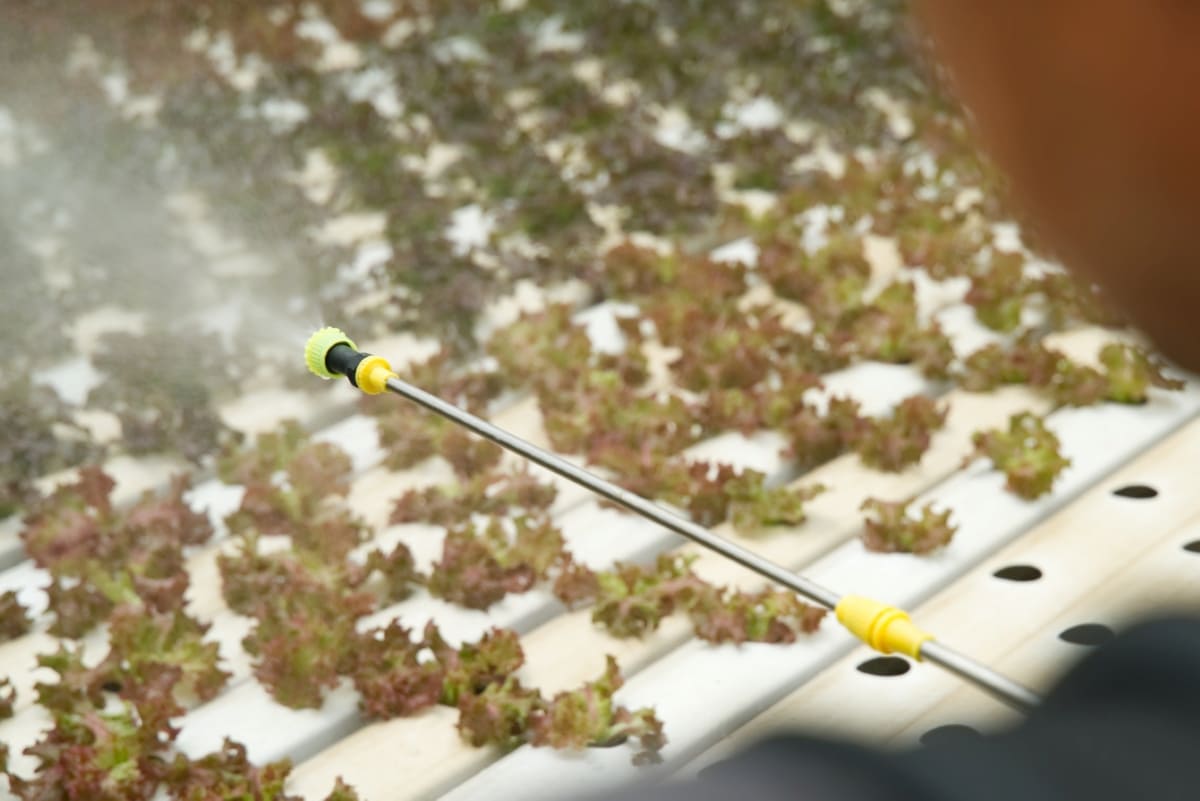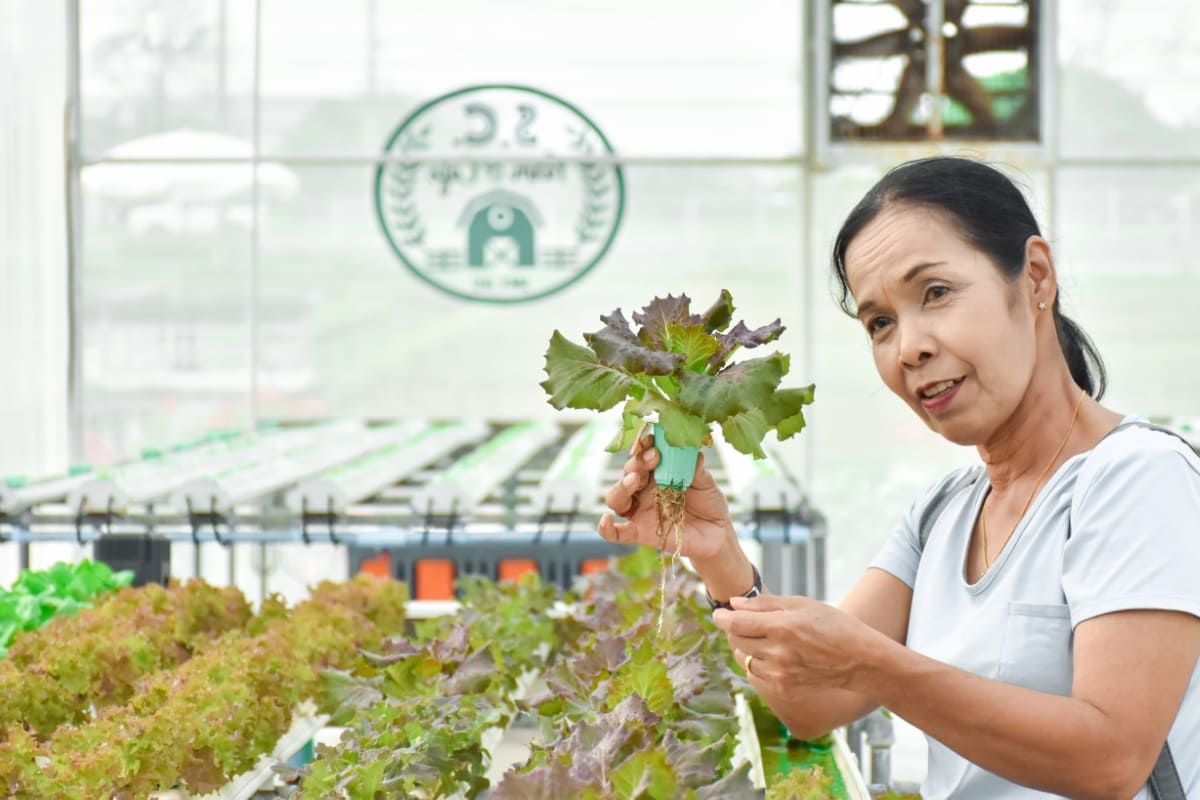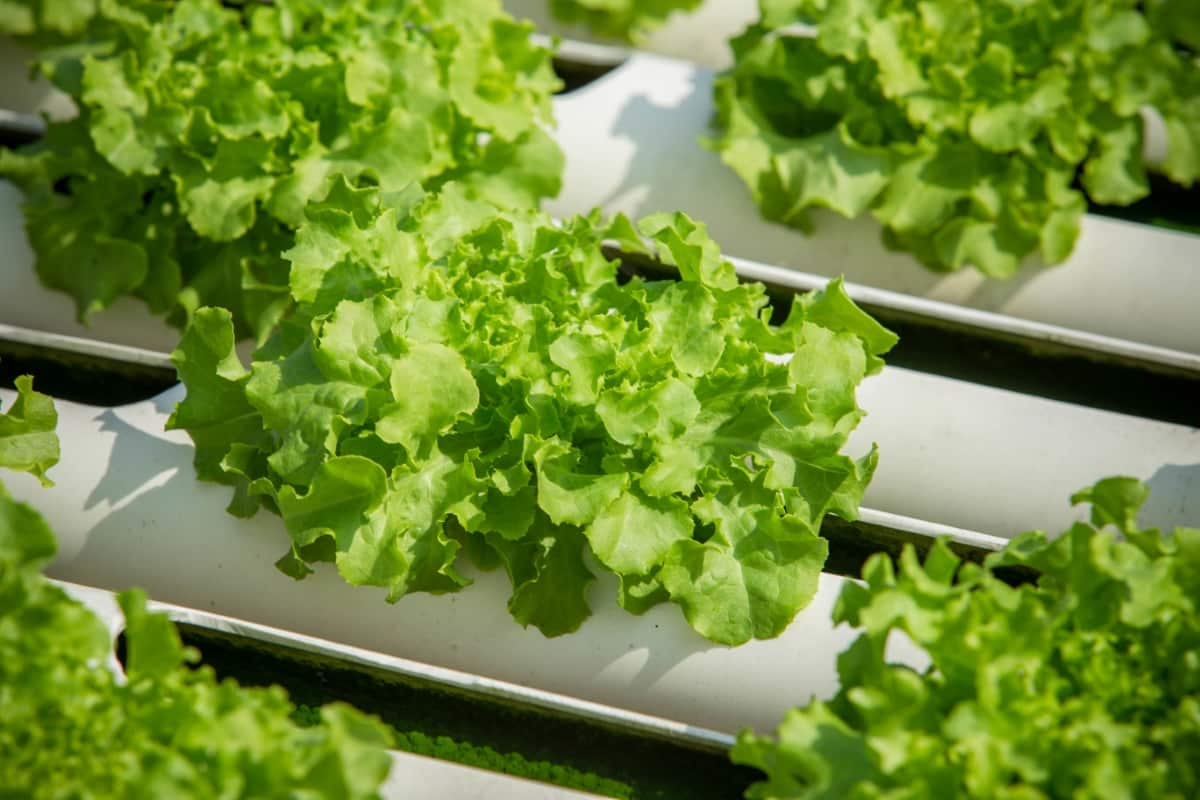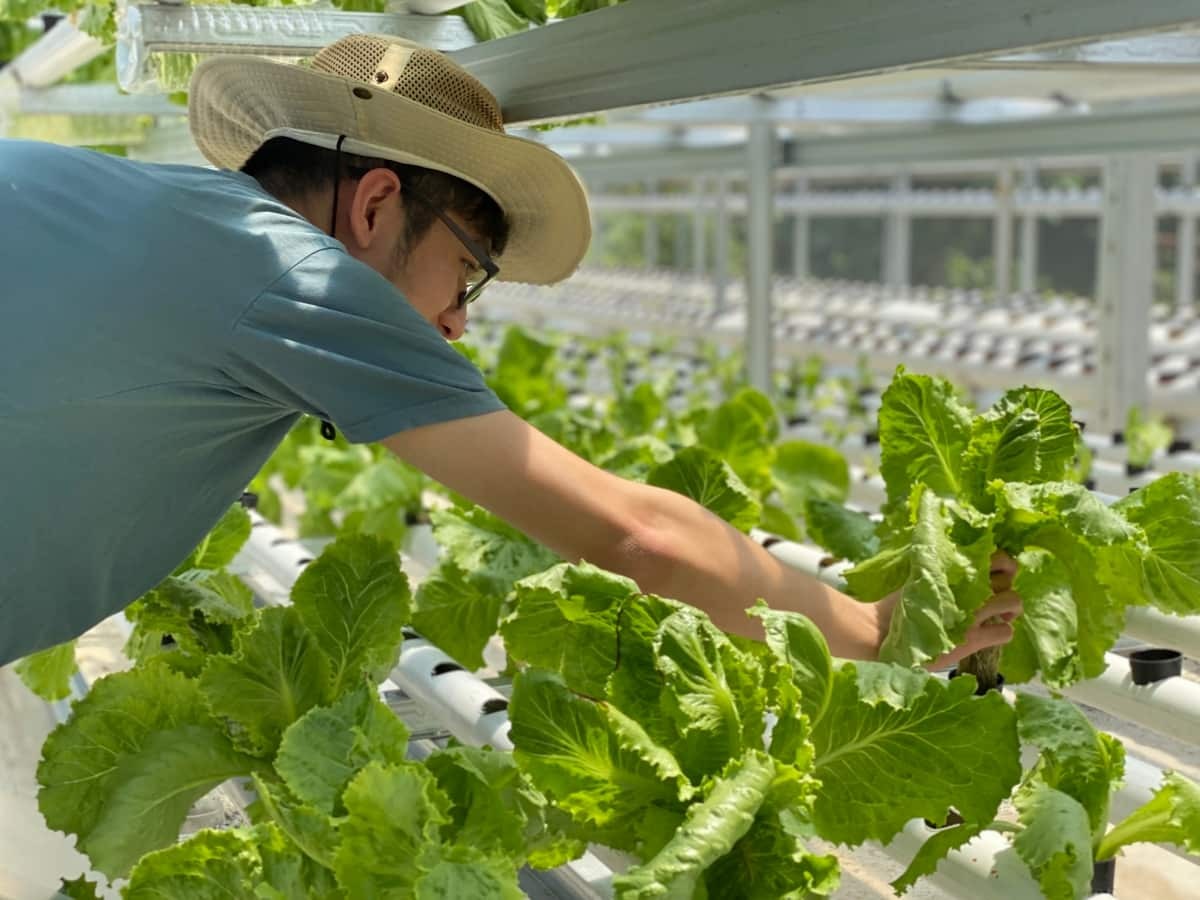Controlling pests and diseases in hydroponic lettuce cultivation is crucial for a healthy and bountiful harvest. In this informative blog, we will explore natural and organic treatments to combat these issues effectively. From common pests like aphids and whiteflies to diseases such as powdery mildew, we’ll delve into scientific strategies without using artificial chemicals. Get ready to discover sustainable solutions to protect your hydroponic lettuce crop and ensure a thriving, pesticide-free harvest.

How to Control Hydroponic Lettuce Pests and Diseases Naturally
Hydroponic Lettuce
Hydroponic lettuce is a way of growing lettuce without soil, using a nutrient-rich water solution instead. This method has advantages, such as faster growth, higher yields, and better taste. Hydroponic lettuce can be grown in different systems, such as water culture, where the plants float on top of the water, or NFT, where the water flows through a thin film. Hydroponic lettuce can be harvested in about a month and stored in the refrigerator for up to a week.
Identifying Common Pests in Hydroponic Lettuce
- Aphids: Aphids are common invaders in lettuce gardens. To combat them naturally, it’s essential to stay informed about aphid control methods. Consider using beneficial insects like ladybugs or releasing lacewings, natural aphid predators. You can also create a homemade neem oil spray to deter aphids.
- Caterpillars: Caterpillars can munch on your lettuce leaves. Implement natural control methods such as handpicking caterpillars and encouraging natural predators like birds. You can also cover your lettuce with row covers to prevent caterpillar infestations.
- Loopers: Loopers are notorious for causing damage to lettuce. To treat them organically, use Bacillus thuringiensis (BT), a naturally occurring bacteria that targets caterpillar-like insects. BT is a practical, environmentally friendly solution.
- Cutworms: Cutworms are another common lettuce pest. To get rid of them naturally, place cardboard collars around the base of your lettuce plants to create a barrier. These collars prevent cutworms from reaching the plant.
- Snails and Slugs: These slimy intruders can harm your lettuce crop. Employ natural control methods like diatomaceous earth, copper tape, or beer traps to deter and catch snails and slugs.
- Leafminers: Leafminers are tiny but destructive. Combat them by applying insecticidal soap or using neem oil on your plants. These organic treatments can effectively deter leafminers.
- Whiteflies: Whiteflies may infest your lettuce. Consider natural treatments like releasing predatory insects like parasitic wasps or using reflective mulch to confuse and deter whiteflies.
- Grubs: To control grubs organically, use diatomaceous earth or insecticidal soap, which is readily available at garden centers.
In case you missed it: How to Identify and Treat Lettuce Pests: Damage Symptoms, Prevention, and Control

- Armyworms: Combat armyworms with insecticidal soap or other organic pesticides.
- Leafhopper: Use neem oil or other substances with intense flavors to repel leafhoppers naturally. Creating a diverse garden ecosystem can also help keep these pests in check.
- Nematodes: If nematodes are present, use insecticidal soap or other approved pesticides to eliminate them from your lettuce crop.
- Thrips: Control thrips naturally by introducing predatory insects like lacewings or using insecticidal soap as a preventive measure.
- Flea Beetles: Combat flea beetles with insecticidal soap or neem oil, which can deter these pesky insects effectively.
Identifying Common Diseases in Hydroponic Lettuce
- Mold: Prevent mold by ensuring proper air circulation around your lettuce. Avoid overcrowding and maintain good ventilation.
- Fusarium Wilt: Remove infested plants promptly to prevent the spread of this severe disease in your garden.
- Downy Mildew: Utilize fungicides from the garden center to control downy mildew on lettuce.
- Powdery Mildew: Learn how to control powdery mildew through proper cultivation practices and potential natural remedies.
- Bottom Rot: Avoid bottom rot by promoting good air circulation and preventing waterlogging in your growing environment.
- Ring Spot: Rare but possible. Eliminate infested plants to prevent ring spots from spreading.
- Pythium: Use potent fungicides from the garden center to address pythium issues.
- Leaf Spot: Implement natural measures to eliminate bacterial leaf spots, such as pruning affected leaves and practicing proper hygiene in your garden.
- Basal Rot: A combination of fungicides and pesticides can help control basal rot in lettuce plants. Be sure to use these products as directed.
Preventive Measures for Controlling Hydroponic Lettuce Pests and Diseases
To control pests and diseases in hydroponic lettuce, follow these preventive measures: choose resistant lettuce varieties, start with healthy seeds, sterilize the system before planting, maintain optimal environmental conditions, inspect plants regularly for signs of pests and diseases, remove infected plants, cut dead or damaged leaves, and keep the system clean.
Natural and Organic Treatments for Hydroponic Lettuce Pests and Diseases
Natural and organic treatments can also combat pests without resorting to harsh chemicals.
- Using a nutrient solution every two weeks or as needed.
- Using a pH balance of 7-9.
- Using a combination of control methods to control pests and diseases
In case you missed it: How to Control Hydroponic Tomato Pests and Diseases Naturally: How to Get Rid of Them with Natural and Organic Treatment

Beneficial Insects for Pest Control in Hydroponic Lettuce Systems
Hydroponic lettuce systems can be effectively controlled by introducing beneficial insects that prey on or parasitize harmful pests. These natural enemies reduce their population and damage without harming plants. Some beneficial insects include ladybugs, lacewings, predatory mites, and parasitic wasps.
Ladybugs feed on soft-bodied pests like aphids, whiteflies, mealybugs, and scale insects, while lacewings feed on aphids, whiteflies, caterpillars, mites, and scale insects. Predatory mites feed on spider mites, causing yellowing, stippling, webbing, and defoliation of leaves. Parasitic wasps lay eggs inside other insects, feeding on the host insect until it dies.
Companion Planting to Deter Pests in Hydroponic Lettuce Gardens
Companion plants, such as basil, marigolds, garlic, mint, and neem oil, can help deter pests in hydroponic lettuce gardens. Basil repels aphids, whiteflies, and thrips, while marigolds attract beneficial insects. Garlic repels pests with its pungent odor and antifungal properties, while mint improves lettuce’s flavor and growth. Neem oil is a natural solution for hydroponic lettuce pest control, as it is a natural solution that can be grown alongside lettuce. These plants work together to enhance the lettuce’s growth and flavor.
Neem Oil: A Natural Solution for Hydroponic Lettuce Pest Control
Neem oil, derived from neem tree seeds, is a potent pest control solution for hydroponic lettuce. Its antibacterial properties prevent insects from feeding, molting, or spreading diseases. It coats leaves, preventing fungal spores and bacteria from infecting. To use, dilute with water and add essential oils. Avoid spraying in hot weather or direct sunlight.
Using Essential Oils as a Natural Defense Against Hydroponic Lettuce Pests
Some of the essential oils that can be used for hydroponic lettuce are peppermint, rosemary, thyme, lavender, and neem. These oils are diluted with water and sprayed on the leaves or roots of the lettuce or added to the nutrient solution. However, essential oils should be used with caution, as they can also harm beneficial insects or damage plants if applied too much or too often.
Homemade Remedies for Controlling Hydroponic Lettuce Pests and Diseases
Some of the ingredients used for this purpose are garlic, onion, chili pepper, vinegar, baking soda, and hydrogen peroxide. These ingredients can be mixed with water and sprayed on the affected areas of the lettuce or added to the nutrient solution. They can help to repel or kill pests, prevent or cure fungal infections, and boost the immune system of the plants.
In case you missed it: How to Control Grape Pests Naturally: How to Get Rid of Them with Natural and Organic Treatment

Conclusion
Safeguarding your hydroponic lettuce from pests and diseases is achievable through natural and organic methods. By staying informed and implementing these eco-friendly strategies, you can enjoy a healthy and pesticide-free lettuce harvest.
- Beneficial Insects in Pest Management
- Natural Solutions for Pest Control in Flower Gardens
- Types of Fungicides Used in Agriculture
- Common Issues in the Fruit Development Stage of Pomegranate Farming
- Fruit Development Issues in Papaya: Easy Solutions and Treatment
- Soil-Borne Diseases and How to Protect Your Plants
- Practices to Prevent Disease Spread in the Garden
- From Wilted to Thriving: How to Treat Root Rot Naturally in Houseplants
- Natural Remedies to Cure Brown Spots on Fig Tree Leaves